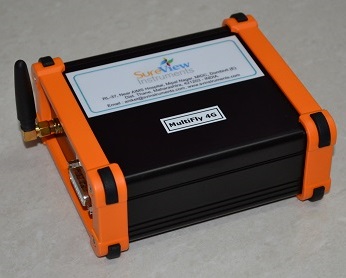Industrial Internet of Things
First of all, let’s understand data acquisition and instrumentation. A data acquisition device reads sensors mostly with analog inputs that take 0-10V or 4-20mA. Any DAQ has digital inputs which have the capability to read counters as well. From IIoT point of view, if you are building a new plant, you can select IoT-sensors and DAQ devices that can send data to a cloud with our without an IOT edge device. We offer IoT-sensors and single board edge devices that take care of this need. Such devices have an onboard WiFi which transfers data to a central location which is connected to the cloud. In some cases, the devices themselves have a port or modem through which they continuously communicate with the cloud to-and-fro like our MultiFly 4G.

In many scenarios, your task is to IoT enable the process, wherein you have existing systems. The logical path is to just replace the DAQs with the ones which can be connected to the cloud. This is painful since it will call for unnecessary spending on functionality that you already have! A smart choice is to introduce an IoT device like SureView MultiFly 01 or MultiFly 4G . If you have a distributed control system as in refineries, production or chemical plant, you need to add edge devices which are compatible with your PLC. A hack would be to connect the database or HMI to the cloud using a software running on the HMI. In most cases, users implement a conventional PLC system that transfers data via an OPC Server to cloud or the enterprise network. We have various products available that not only connect your 3rd party data acquisition devices but can also read sensors directly with on-board ADCs. Thus, finding and using IoT devices compatible with your existing instruments/systems instead of buying everything new is an intelligent decision.
Controller
Secondly, comes the Controller which automates the complete process. Generally the size of the entire project, the sophistication of the system and compatibility requirements dictate which controller to use. In the smaller systems, a smart IoT-sensor with an App might be enough, thereby eliminating the controller altogether. In many cases a single board industrial-grade computer will be sufficient as even the basic SBCs available on market (at the time of this writing) pack enough power. With ethernet ports on each SBCs it is possible to realise large-scale automation projects at a substantially low cost. All the SBCs we make are real-time, industrial-grade and come with built-in 4G modem (or WiFi & Ethernet port).
Since PLC (such as Siemens Simatic or Allen-Bradley) are a popular choice amongst engineers in India for industrial automation, we have made sure that all our sensors, DAQ boards and other IoT-devices we make are compatible with PLCs in addition to PCs.

Cloud

Then, there is the cloud. In almost all of our projects until now, we have used Microsoft Azure or Amazon AWS. In some cases, for needs of data-sovereignty, some enterprises choose a hybrid-cloud (in a hybrid cloud, data & apps reside partly on Azure/AWS and partly on your in-premise server). Since both Microsoft & Amazon are very secure and have servers in multiple countries including India, it’s not recommended to use hybrid-cloud unless your IT policy requires you to do so. Depending upon size of your IoT-application you should choose between software-as-a-service, platform-as-a-service or infrastructure-as-a-service. For large websites such as travel portals or any government services, you might need to select Infrastructure-as-a-service for various reasons such as economy. This is only recommended if you have a dedicated IT team who can look after the cloud activities, otherwise it’s actually costly and needlessly complex. For most projects, we have figured-out that platform-as-a-service is the best selection to host any IoT Application. PaaS is not only low-cost & flexible but also provides great tools to build your software & web apps.
Software in IoT

If you let us architect a complete IOT enabled Industrial Automation solution for your factory or laboratory, we take unique approach:
It’s common sense that lesser the number of devices you use, the higher is the reliability and lower is the cost. Normally the solution proposed by vendors is a multi-layer architecture comprising of:
- Sensors, Actuators & Remote Terminal Units
- PLC, DCS & SCADA
- OPC Server
- Edge Devices & Gateways
- Cloud
- UI & Apps
- A separate analytics package
We have an alternate approach that has all the required benefits but with lesser complexity & lower cost. We have supplied such systems to leading companies in India. Such IoT solutions comprise of:
- Sensors & Actuators
- SBC
- Cloud
- Local & Web-based UI and Apps (both Android & iOS)
- Analytics
Of course, the selection of parts depends on the actual requirement and nature of control & automation system. Please feel free to contact us for a obligation-free quotation and consultation. We have supplied end-to-end IoT-enabled Industrial Automation solutions to leading companies in India including Reliance Industries Limited, Philips, Siemens, Eaton, UL, ABB and others.
This blog post will give you insight about how one can start with IoT in a scenario where there is machinery that needs to be made smart.
For most new Industry 4.0 projects, our 4G DAQ called MultiFly 4G is a great instrument to use. It not only connects any sensor to cloud but also reads other instruments so as to send their measurements to your cloud.
If you want to know background information about our past projects, here’s a portfolio-page.
We maintain a blog for our Industry 4.0 projects here – https://sureview.blog/blog/
Please contact us for your Industry 4.0 requirement!

